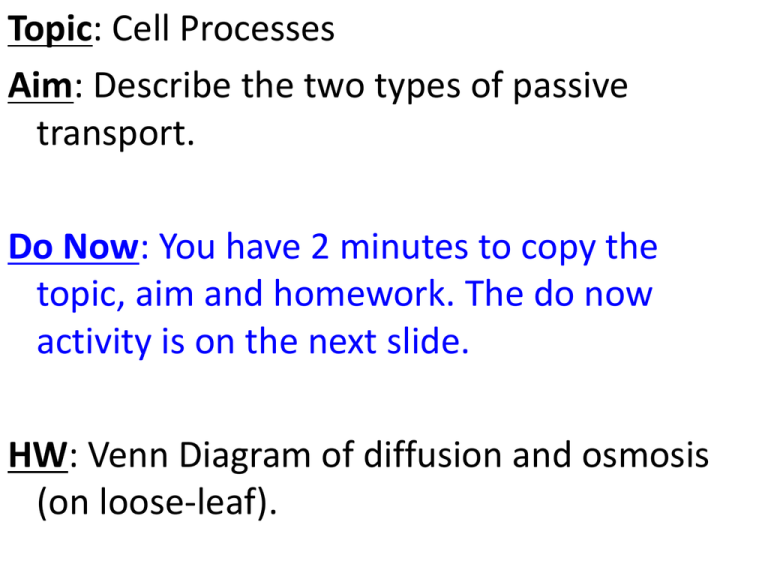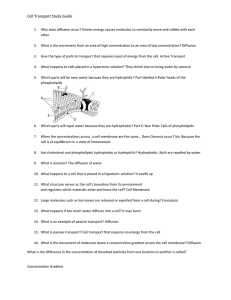2 Types of Passive Transport
advertisement

Topic: Cell Processes Aim: Describe the two types of passive transport. Do Now: You have 2 minutes to copy the topic, aim and homework. The do now activity is on the next slide. HW: Venn Diagram of diffusion and osmosis (on loose-leaf). Exit Card…5 minutes Compare and contrast passive and active transport by completing one of the following. Write a paragraph of at least 4 sentences comparing and contrasting passive and active transport. Be sure to use the following terms: particles, energy, high concentration, low concentration. OR Compare and contrast passive and active transport by drawing diagrams of each type. Be sure to label the particles, high concentration, low concentration, energy. Draw an arrow showing the movement of the particles. http://www.online-stopwatch.com/ Identify the 2 types of passive transport. DIFFUSION LOW HIGH 1. Identify the high and low concentration. 2. Identify the type of transport the diagram represents. 3. When will this process stop? Diffusion • Movement of particles from a HIGH to LOW concentration • NO ENERGY • Ex: CO2, O2, glucose, sucrose, H2O, etc… The animation above is showing the movement of glucose molecules across a membrane. Describe what is happening in this process. Explain why this diagram represents diffusion. HIGH LOW The diagram represents water molecules moving. 1. Identify the high and low concentration. 2. Describe how the water molecules will move. 3. Identify the type of passive transport occurring. Support your answer. Osmosis Cell membrane Inside cell High conc. of water molecules. Outside cell Low conc. of water molecules. Osmosis Cell membrane OSMOSIS Inside cell High conc. of water molecules. Outside cell Low conc. of water molecules. • Movement of WATER molecules through a membrane from a HIGH to LOW concentration • NO ENERGY https://www.youtube.com/watch?v=XXVc7HXjRp8 What happens when a cell is placed in a SALT SOLUTION? 33% H2O 72% H2O • H2O ALWAYS diffuses OUT of the cell Normal red blood cell and normal plant cell Red blood cell and plant cell surrounded by salt solution What happens when a cell is placed in a DISTILLED WATER? 100% H2O 72% H2O • Water ALWAYS diffuses INTO the cell Normal red blood cell and normal plant cell Red blood cell and plant cell in distilled water What happens when a cell is placed in a solution with the same water concentration? 72% H2O 72% H2O • Cell remains the same 1. Identify the type of transport occurring when the molecules move from area A to area B. Support your answer Passive transport Molecules are moving from a HIGH to LOW concentration. 2. Identify the type of transport occurring when the molecules move from area B to area A. Support your answer. Active transport Molecules are moving from a LOW to HIGH concentration. 3. Identify the type of passive transport occurring if WATER molecules move from area A to area B. Support your answer. Osmosis WATER is moving from a HIGH to LOW concentration. 4. Identify the type of passive transport occurring if glucose molecules move from area A to area B. Support your answer. Diffusion GLUCOSE is moving from a HIGH to LOW concentration. The movement of materials from higher to lower concentration is called 1. diffusion 2. active transport 3. pinocytosis 4. phagocytosis Which process requires cellular energy? 1. diffusion 2. passive transport 3. active transport 4. osmosis The movement of water from higher to lower concentration is called 1. pinocytosis 2. active transport 3. osmosis 4. phagocytosis Damage to which structure will most directly disrupt water balance within a single-celled organism? 1. ribosome 2. cell membrane 3. nucleus 4. chloroplast Sodium ions are pumped from a region of lower concentration to a region of higher concentration in the nerve cells of humans. This process is an example of 1. diffusion 2. osmosis 3. passive transport 4. active transport The movement of materials from lower to higher concentration requiring energy in the form of ATP is called 1. movement 2. diffusion 3. active transport 4. cell division The movement of glucose molecules from a high to low concentration is known as 1. locomotion 2. diffusion 3. active transport 4. osmosis Exit Card… Compare and contrast diffusion and osmosis by completing one of the following. Write a paragraph of at least 4 sentences comparing and contrasting diffusion. Be sure to use the following terms: particles, energy, high concentration, low concentration. OR Compare and contrast diffusion and osmosis by drawing diagrams of each type. Be sure to label the particles or water, high concentration, low concentration. Draw an arrow showing the movement of particles or water. COMPARE Passive and active transport both involve the movement of substances. CONTRAST Passive transport does not require energy while active transport does require energy. During passive transport substances move from a high to low concentration. During active transport substances move from a low to high concentration.



